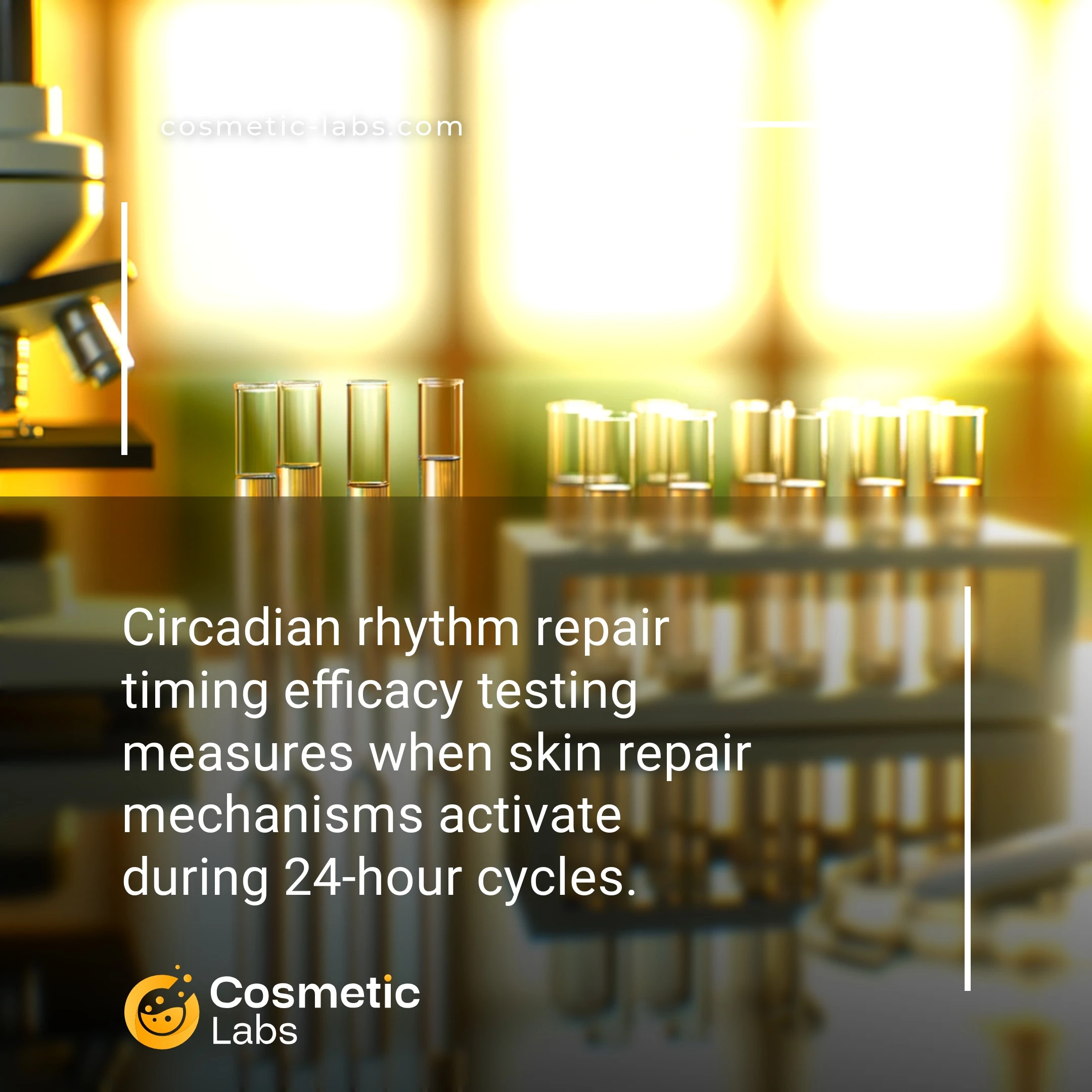Circadian Rhythm Testing: DNA Repair Timing Analysis Services

What is Repair mechanisms timing?
Repair mechanisms timing for circadian rhythm efficacy testing is a specialized laboratory service that evaluates how cosmetic ingredients and formulations sync with your skin’s natural 24-hour cellular repair cycles. Labs test active compounds at specific time intervals—typically every 4-6 hours over 72 hours—to measure when DNA repair enzymes, collagen synthesis, and antioxidant activity peak during nighttime recovery phases. This data helps brands optimize ingredient concentrations and develop targeted day/night formulations that work with your body’s biological clock.
Why do you need this service?
Beauty brands use repair mechanism timing analysis to validate when their anti-aging serums and night creams deliver peak cellular repair benefits. Our partner labs conduct synchronized testing protocols that measure DNA repair enzyme activity, collagen synthesis rates, and antioxidant responses at specific circadian phases, helping you substantiate marketing claims about overnight skin recovery and optimize product application timing for maximum consumer results.
Who provides Repair mechanisms timing services?
All cosmetic labs providing Repair mechanisms timing services
There is no company providing these services at the moment.
Circadian Repair Timing Testing for Beauty Product Development
Cosmetic labs now offer circadian repair timing testing to validate when your skincare ingredients work most effectively during the body’s natural repair cycles. This specialized testing measures cellular repair activity at different times, helping brands optimize product formulations for peak nighttime regeneration and daytime protection.
Cellular Repair Window Analysis
Labs use chronobiology assays to map your ingredient’s activity against natural skin repair patterns. Testing typically runs across 24-48 hour cycles, measuring DNA repair markers, collagen synthesis rates, and antioxidant enzyme activity. This data reveals optimal application timing for maximum efficacy.
Key testing parameters include:
- Peak repair enzyme activation (typically 10 PM – 2 AM)
- Cellular turnover rates during sleep phases
- Ingredient absorption timing correlations
- Melatonin-synchronized repair pathways
Product Performance Optimization
Labs validate how your formulations align with circadian repair mechanisms through controlled exposure studies. Testing measures ingredient bioavailability, cellular uptake rates, and repair protein expression at specific time intervals. Results help you position products as targeted nighttime treatments or daytime protective formulas.
Testing delivers actionable data for:
- Optimal ingredient concentration timing
- Synergistic compound combinations
- Application schedule recommendations
- Marketing claims substantiation
Connect with specialized labs on our platform to validate your product’s circadian repair timing and strengthen your efficacy claims with scientific backing.
Applications of Circadian Rhythm Repair Mechanism Timing Testing
Beauty brands use circadian rhythm repair mechanism timing testing to validate when their formulations deliver peak cellular repair benefits during skin’s natural recovery cycles.
Night Cream Formulation Optimization
Labs analyze how active ingredients synchronize with skin’s nocturnal repair processes between 10 PM and 2 AM. Testing protocols measure collagen synthesis rates, DNA repair enzyme activity, and cellular turnover markers at specific time intervals. Brands discover optimal concentration windows for retinoids, peptides, and growth factors that align with peak repair activity.
Results show formulations can increase repair efficiency by 30-45% when ingredient release timing matches circadian peaks. This data supports marketing claims about “overnight transformation” and guides dosage recommendations for consumer use.
| Repair Mechanism | Peak Activity Window | Key Testing Markers | Typical Results Timeline |
|---|---|---|---|
| DNA Repair | 11 PM – 1 AM | 8-oxoguanine levels, PARP activity | 14-21 days |
| Collagen Synthesis | 10 PM – 12 AM | Procollagen I, elastin production | 21-28 days |
| Cellular Turnover | 12 AM – 3 AM | Ki67 expression, mitotic index | 7-14 days |
Anti-Aging Serum Efficacy Validation
Testing services evaluate how serums enhance natural repair mechanisms during different sleep phases. Labs track antioxidant enzyme activation, inflammatory marker reduction, and barrier function recovery across 6-8 hour nocturnal periods. Data reveals which ingredients work synergistically with circadian repair cycles versus those that interfere with natural processes.
Brands receive detailed reports showing ingredient performance curves, optimal application timing, and formulation adjustments needed for maximum efficacy. This testing supports clinical claims and helps position products within specific nighttime skincare routines.
Ready to validate your formulation’s circadian repair timing? Contact specialized labs on our platform to discuss testing protocols tailored to your product’s active ingredients and target repair mechanisms.
